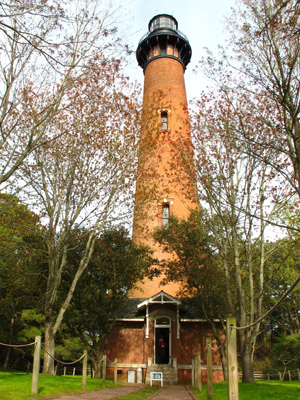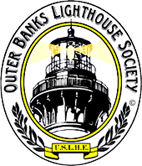CURRITUCK BEACH LIGHTHOUSE
Currituck Beach Light Station
Corolla Village, NC
Latitude: 36° 22' 36.0" N
Longitude: 75° 49' 51.0" W
Congress began discussing the need for a light in the vicinity of Currituck Beach during the 1850s, but it took two decades for a plan to become reality. The long stretch of shoreline with Cape Henry thirty-four miles to the north and Bodie Island thirty-two miles to the south was unprotected and worrisome, but the construction of a lighthouse was delayed because of the Civil War. In 1872, as work on the Bodie Island Lighthouse neared completion, superintendent of construction Dexter Stetson was informed by the Lighthouse Service that once finished, he could move north to what is now known as Corolla and begin construction on a new lighthouse at Currituck Beach. New drawings for this tower were not needed, Stetson was informed, as a decision had been made to use the same drawings used at Bodie Island. With the exception of minor adjustments for the site, the architecture of two lighthouses would be identical.
On December 1, 1875, the first lighting of the Currituck Beach Lighthouse illuminated this dark space on North Carolina’s dangerous coast. It was the final lighthouse built on the Outer Banks of North Carolina and with an overall tower height of 162 feet, it is one of the tallest beacons in the country.

Equipped with a magnificent first-order Fresnel lens, which is still an active aid to navigation, this tower's signature is a single, white, three-second flash followed by seventeen seconds off for three cycles per minute. However, for a number of years, this beacon flashed red from a red glass panel (known as “ruby glass”) that was placed over three of the "bullseye" lens panels on a rotating mechanism around the outside of the lens.
The tower, which contains approximately one million bricks, is unique in that it is the only major tower in the mid-Atlantic region which has never been painted. In addition, just like the Bodie Island Lighthouse, the cast and wrought iron details, including the brackets supporting the gallery, the railings, rosettes, and spiral stairs, are excellent examples of Victorian-era design.
In 1876 the double keepers' quarters was completed. However, once the light was automated in 1939, the keepers' residence was vacated and left for ruin. In January 1952, the thirty-one acres of land and the dwellings on the original light station were transferred to the state of North Carolina for “muskrat research.” Corolla did not have a paved road until the 1980s; thus, its geographic isolation encouraged vandalism on the property and structures. The buildings, including the tower itself whose upkeep was in the hands of the U.S. Coast Guard, fell into disrepair.
In 1980 a group of concerned preservationists called the Outer Banks Conservationists, Inc. (OBC), formed to do something about the overall decay of the light station with a focus on the double keepers’ quarters. In fact, OBC founders, including John Wilson, a visionary who was not only the state’s youngest mayor (of Manteo) but also the great-grandson of the station’s final keeper, Principal Keeper Homer Treadwell Austin, devoted a decade of their personal time and money to renovating it. They had organized the preservation by convincing North Carolina to transfer the property to the Department of Cultural Resources, which could then create a lease agreement between the state and OBC.
In 1990, OBC and the U.S. Coast Guard negotiated a similar agreement whereby OBC would put money into the renovations of the tower in exchange for being allowed to open the tower to the public for a fee. In doing so, OBC made the lighthouse self-supporting and was able to do massive preservation work without government funding or added tax money.
In 2003, the U.S. government donated the tower to OBC for historic, preservation, cultural, and educational use through the National Historic Lighthouse Preservation Act (NHLHPA) administered by the National Park Service (NPS). The U.S. government retained possession of the Fresnel lens while the U.S. Coast Guard is responsible for its active operation.
After OBC acquired the deed to the tower itself, the nonprofit group faced a non-preservation challenge in that Currituck County claimed it should be rightful owner. After years of legal arguments and hundreds of thousands of dollars spent by the county and OBC to take ownership of the light station, it was determined that OBC was the rightful owner of the Currituck Beach Lighthouse. The Outer Banks Lighthouse Society voiced full support for OBC in its bid to become permanent steward of the light station.
Currently, the lighthouse is open mid March through late November. Special events held at the light station include opening day that is a fee-free climb day and often a free-climb birthday party on December 1 annually. The tower is open daily, 9 a.m.-5 p.m., weather permitting, with some extended summer hours. Climbing fees are $10/person although children under seven years of age can enter for free with an adult. Parking and admission onto the grounds is free. Visitation and climbing the tower are self-guided and visitors may spend as much time on the grounds and in the tower as they would like. Docents, brochures, and displays are found inside and outside the tower to help inform visitors. Climbers have nine landings to scale while ascending the 220 stairs where they can enjoy educational displays and beautiful views on the way to the outside gallery, which sits about 140 feet above the ground. The top of the lighthouse is 162 feet from ground level, and the focal plane of the lens shines from 158 feet above sea level.
Season passes are available for unlimited climbing: $50 for an individual, $120 for a family (5), and +$30 to add another person on to the pass.
Visitors should come with cash or checks for climbing fees.
Near the lighthouse are other cultural and natural resources visitors can enjoy. Whalehead in Historic Corolla (a 1920s mansion open for tours), the Outer Banks Center for Wildlife Education, the Corolla Wild Horse Museum, public beach areas, Currituck Sound access, and historic Corolla Village are all a must-see for visitors who make the trip to visit the lighthouse. For more information visit the Currituck Beach Lighthouse website.
Directions
Take NC 12 North from US 158 in Kitty Hawk to Corolla. The lighthouse is visible from the road on your left.
